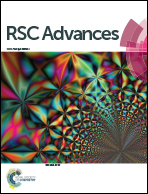Highly efficient, reversible iodine capture and exceptional uptake of amines in viologen-based porous organic polymers†
Abstract
A viologen-based porous organic polymer, POP-V-VI, was designed and synthesized by a facile nucleophilic substitution between cyanuric chloride and 1,2-bis(4-pyridinium) ethylene. Together with the reported POP-V-BPY with a similar structure, these viologen-based porous organic polymers bear high charge density, phenyl ring and nitrogenous affinity sites, which endow them with excellent iodine vapor uptake capacity (4860 mg g−1 for POP-V-VI and 4200 mg g−1 for POP-V-BPY) and remarkably high adsorption capacity for pyridine (4470 mg g−1 for POP-V-VI and 8880 mg g−1 for POP-V-BPY) and other aliphatic amines. POP-V-VI and POP-V-BPY could be efficiently recycled and reused three times without significant loss of iodine vapor uptake. All these results demonstrate that POP-V-VI and POP-V-BPY are promising adsorbents for practical applications in portable devices such as gas masks.



 Please wait while we load your content...
Please wait while we load your content...